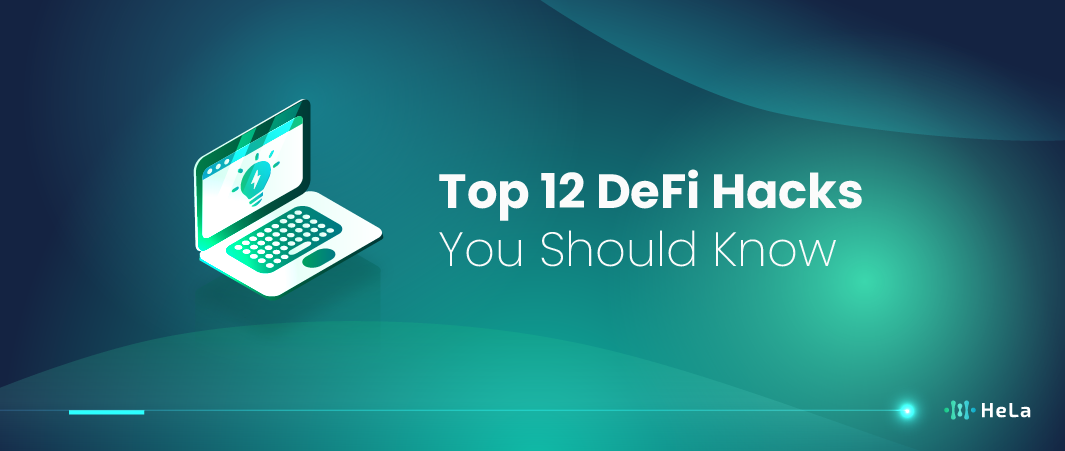This article will explore the Top 12 DeFi Scams and Hacks to Protect Yourself in 2025. We’ll dissect notable case studies of breaches that have sent shockwaves through the DeFi community, detailing how they occurred and what lessons can be learned. Additionally, we will provide actionable tips and best practices to help you safeguard your assets against potential threats. By arming yourself with knowledge and awareness, you can better navigate the exhilarating yet perilous waters of DeFi and make informed decisions that will protect your investments and financial future.
As the world of decentralized finance (DeFi) continues to grow exponentially, it simultaneously opens doors to numerous opportunities and exposes users to a myriad of risks. The allure of DeFi platforms lies in their promise of high returns and financial innovation, allowing individuals to lend, borrow, and trade without traditional intermediaries. However, this unregulated space has become a breeding ground for scams and hacks, leading to substantial financial losses for unsuspecting investors. In 2025, various reports highlighted that billions of dollars were siphoned off through fraudulent schemes and security breaches, raising critical concerns about the safety and security of DeFi ecosystems.
Understanding DeFi Security Risks
In recent years, Decentralized Finance (DeFi) has gained immense popularity, offering innovative financial solutions that leverage blockchain technology. However, this rapid growth has also attracted a significant number of security risks and vulnerabilities. DeFi operates without intermediaries, relying on smart contracts to facilitate transactions and automate processes. While this decentralization enhances transparency and accessibility, it also exposes users to a range of threats, including hacks, scams, and technical exploits.
Also Read: Top 10 Decentralized Storage Projects in 2025
The absence of regulatory oversight makes DeFi platforms particularly appealing to malicious actors looking to exploit weaknesses for financial gain. For instance, high-profile incidents like the $600 million hack of the Poly Network and numerous rug pulls highlight the precarious nature of investing in DeFi projects. As the DeFi space continues to evolve, understanding these security risks becomes paramount for investors seeking to protect their assets and navigate the complexities of this new financial landscape. Awareness of potential threats and implementing best practices for security are essential steps in safeguarding investments against the ever-present dangers lurking in the DeFi ecosystem.
Understanding Common DeFi Scams

Understanding common DeFi scams is crucial for anyone looking to navigate the decentralized finance landscape safely. As DeFi continues to attract more users, it also becomes a prime target for malicious actors employing various tactics to deceive investors. One prevalent scam is the “rug pull,” where developers abandon a project after attracting substantial investments, leaving investors with worthless tokens. This typically occurs in projects with minimal transparency, where the team behind the project has limited accountability. Another common scam is the “phishing attack,” in which scammers impersonate legitimate platforms or services to steal users’ private keys or login credentials. These attacks often occur through fake websites or deceptive emails, tricking users into providing sensitive information.
Moreover, “smart contract vulnerabilities” present significant risks, as flaws in the code can be exploited, leading to substantial financial losses. Users must also be wary of “pump and dump” schemes, where the price of a token is artificially inflated through misleading information, only for the scammers to sell off their holdings at the peak, leaving other investors to face the financial consequences. Understanding these scams and their mechanics is vital for safeguarding assets and making informed decisions in the rapidly evolving DeFi ecosystem. By staying informed and exercising caution, users can better protect themselves against the pitfalls that accompany the promise of decentralized finance.
Top 12 DeFi Scams and Hacks to Protect Yourself in 2025

Decentralized Finance (DeFi) has revolutionized the financial landscape, offering a range of innovative services. However, with its rapid growth, it has also become a target for various scams and hacks. Here’s an in-depth look at the top 12 DeFi scams and hacks in 2025, along with ways to protect yourself from these threats.
1. Rug Pulls
Rug pulls are one of the most notorious scams in the DeFi space. This occurs when developers abandon a project after attracting significant investments, effectively stealing all funds from investors. A notable example is Compounder Finance, which saw millions of dollars vanish overnight. To protect yourself, always research the team behind a project, check for code audits, and look for signs of transparency. Trust projects that are open about their development processes and have a strong community backing.
- What It Is: A rug pull occurs when developers abandon a project after attracting investments, taking all funds with them.
- Example: Projects like “Compounder Finance” saw millions vanish overnight.
- How to Protect Yourself:
- Research the team behind a project.
- Check for code audits and transparency.
2. Phishing Attacks
Phishing attacks are designed to trick users into revealing their private keys or recovery phrases through fake websites or emails. For instance, a fake Uniswap website led to several users losing their funds due to their trust in a fraudulent platform. To avoid falling victim to such attacks, always double-check URLs and use bookmarks for websites you frequently visit. Be skeptical of unsolicited messages requesting sensitive information.
- What It Is: Scammers create fake websites or send fraudulent emails to trick users into revealing private keys or recovery phrases.
- Example: A fake Uniswap website led to multiple users losing their funds.
- How to Protect Yourself:
- Always double-check URLs.
- Use bookmarks for frequently visited sites.
3. Smart Contract Exploits
Hackers often target vulnerabilities in smart contracts to siphon off funds. A significant case was the hack of BoringDAO, where a bug was exploited, resulting in massive financial losses. Protect yourself by investing in projects with a solid track record and third-party audits. Keep informed about the latest security practices and vulnerabilities in DeFi.
- What It Is: Hackers exploit vulnerabilities in smart contracts to drain funds.
- Example: The “BoringDAO” hack exploited a bug, leading to significant losses.
- How to Protect Yourself:
- Invest in projects that have undergone third-party audits.
- Stay informed about known vulnerabilities.
4. Liquidity Mining Scams
Liquidity mining scams entice investors with promises of high yields before vanishing with their funds. Many users were scammed by fraudulent liquidity pools that offered unsustainable returns. To safeguard against these scams, be wary of platforms that guarantee unrealistic yields. Always conduct thorough research on the project’s viability and the underlying mechanisms of its yield generation.
- What It Is: Fake platforms offer high yields to attract liquidity, then vanish with investors’ funds.
- Example: Many users were scammed by fraudulent liquidity pools promising unsustainable returns.
- How to Protect Yourself:
- Avoid platforms that promise unrealistic returns.
- Conduct thorough research before investing.
5. Token Theft
Token theft can occur when scammers manipulate the token distribution process during ICOs (Initial Coin Offerings), leading to significant financial losses for unsuspecting investors. A prominent example was the Spring 2024 ICO, which compromised its distribution process. To protect yourself, only participate in ICOs through trusted platforms and verify project legitimacy through community feedback and established reputations.
- What It Is: Scammers manipulate the token distribution process to steal funds during initial coin offerings (ICOs).
- Example: The “Spring 2024 ICO” lost millions due to a compromised distribution process.
- How to Protect Yourself:
- Use trusted platforms for ICO participation.
- Verify project legitimacy through community feedback.
6. Exit Scams
Exit scams happen when founders or key team members disappear after raising substantial funds, leaving investors with worthless tokens. There have been multiple cases in the past where projects abruptly halted operations, causing severe financial repercussions for their supporters. To mitigate the risk of exit scams, look for projects with transparent roadmaps, regular updates, and active community engagement.
- What It Is: Founders or team members of a project disappear after raising funds, leaving investors with worthless tokens.
- Example: Several DeFi projects in 2023 had founders vanish after fundraising.
- How to Protect Yourself:
- Look for projects with transparent roadmaps and regular updates.
- Engage with the community for feedback.
7. Flash Loan Attacks
Flash loan attacks involve hackers taking advantage of smart contract vulnerabilities to execute large trades that lead to significant financial losses. The Alpha Homora hack is a stark reminder of this risk. To protect your investments, focus on well-established protocols that have proven security measures. Staying informed about the latest threats and security practices can also help mitigate this risk.
- What It Is: Hackers use flash loans to exploit vulnerabilities in DeFi protocols, often leading to significant financial losses.
- Example: “Alpha Homora” faced massive losses due to a flash loan attack.
- How to Protect Yourself:
- Invest in well-established protocols with a track record of security.
- Stay updated on security practices in DeFi.
8. Front-Running
Front-running occurs when scammers exploit transaction ordering to profit from knowing other users’ pending transactions. Instances of bots manipulating trades have been reported, disadvantaging ordinary users. To avoid front-running, trade on decentralized exchanges that implement measures to protect against this practice. It’s also wise to be cautious when making large trades that could attract attention.
- What It Is: Scammers take advantage of transaction ordering to profit at the expense of other users.
- Example: Instances where bots manipulated trades by knowing pending transactions.
- How to Protect Yourself:
- Use decentralized exchanges that have measures to prevent front-running.
- Avoid large trades that can trigger front-running.
9. Fake Airdrops
Fake airdrops are scams where attackers promote fraudulent token distributions to collect users’ private keys or funds. Numerous users have lost assets due to fake airdrop claims. To protect yourself, be skeptical of unsolicited airdrop offers and never provide personal information or private keys for airdrops. Research the legitimacy of the airdrop before engaging.
- What It Is: Scammers promote fake airdrops to collect users’ private keys or funds.
- Example: Numerous users fell for fake airdrops claiming to distribute popular tokens.
- How to Protect Yourself:
- Be skeptical of unsolicited airdrop offers.
- Never provide personal information or private keys for airdrops.
10. Yield Farming Scams
Yield farming scams lure investors by promising high yields, only to turn out to be fraudulent projects. Many users have been misled into investing in projects that ultimately were scams. Protect yourself by conducting thorough research on any yield farming opportunities and only engaging with established platforms that have proven track records.
- What It Is: Fraudulent projects lure investors with the promise of high yields through yield farming.
- Example: Many users invested in projects that turned out to be scams.
- How to Protect Yourself:
- Research the project’s liquidity and tokenomics.
- Stick to established platforms for yield farming.
11. Stolen Private Keys
Stolen private keys can result from users unknowingly exposing their keys through insecure wallets or phishing sites. Several individuals have faced significant losses when their private keys were compromised. To avoid this, use hardware wallets for secure storage of your keys and enable two-factor authentication on your accounts whenever possible.
- What It Is: Users unknowingly expose their private keys through insecure wallets or phishing sites, leading to stolen assets.
- Example: Several individuals lost significant amounts when their private keys were compromised.
- How to Protect Yourself:
- Use hardware wallets for secure storage.
- Enable two-factor authentication wherever possible.
12. Insider Trading
Insider trading in DeFi involves team members using non-public information to gain an unfair advantage over other investors. There have been instances where insiders profited from their knowledge of upcoming developments before the information became public. To safeguard against this, engage with projects that prioritize transparent communication and consider investing based on comprehensive analysis rather than insider tips.
- What It Is: Team members or insiders exploit non-public information to gain an unfair advantage.
- Example: Incidents of insiders profiting from information about upcoming developments.
- How to Protect Yourself:
- Participate in projects with transparent communication.
- Be cautious about investing based on insider tips.
Common Vulnerabilities in DeFi Protocols

Understanding the common vulnerabilities in DeFi protocols is crucial for both developers and investors. By identifying and addressing these weaknesses, the DeFi community can work towards creating more secure and resilient systems. Here are some of the most prevalent vulnerabilities in DeFi protocols:
Smart Contract Bugs
One of the most significant vulnerabilities in DeFi protocols is the presence of bugs in smart contract code. These bugs can arise from coding errors, logical flaws, or overlooked edge cases. Even minor errors can be exploited by attackers to drain funds or manipulate the protocol. Ensuring thorough code audits and employing formal verification methods can help mitigate these risks.
Reentrancy Attacks
Reentrancy attacks occur when an attacker repeatedly calls a function within a smart contract before the previous function execution is completed. This can lead to unexpected behavior and allow the attacker to manipulate the contract’s state. Proper use of reentrancy guards and following best practices in smart contract design can help prevent such attacks.
Flash Loan Exploits
Flash loans allow users to borrow large sums of cryptocurrency without collateral, provided the loan is repaid within the same transaction. While flash loans have legitimate uses, they can also be exploited to manipulate prices, drain liquidity, or perform complex arbitrage attacks. Protocols need to implement safeguards to detect and prevent malicious flash loan usage.
Oracle Manipulation
Many DeFi protocols rely on oracles to provide external data, such as asset prices. If an oracle is compromised or manipulated, it can lead to incorrect data being fed into the protocol, resulting in erroneous calculations and potential exploits. Using decentralized oracles and implementing multiple data sources can enhance the reliability and security of oracle data.
Front-End Vulnerabilities
While smart contract security is critical, vulnerabilities can also exist in the front-end interfaces that users interact with. Phishing attacks, malicious code injections, and other front-end exploits can lead to users unintentionally granting attackers access to their funds. Regular security audits and user education are essential to protect against these threats.
Rug Pulls and Exit Scams
Rug pulls occur when developers of a DeFi project withdraw all the funds from the liquidity pool and disappear, leaving investors with worthless tokens. Exit scams involve developers abandoning a project after collecting substantial funds from investors. Ensuring transparency, conducting thorough due diligence, and avoiding anonymous projects can help mitigate the risk of rug pulls and exit scams.
By understanding and addressing these common vulnerabilities, the DeFi community can work towards creating more secure and reliable protocols. Continuous improvement, regular audits, and a focus on best practices are essential to protect against the evolving threats in the DeFi space.
How to Protect Your DeFi Investments

Investing in DeFi offers exciting opportunities but also comes with significant risks. Protecting your investments requires a proactive approach and a solid understanding of best practices. Here are several strategies to help safeguard your DeFi assets:
- Conduct Thorough Research: Before investing in any DeFi project, conduct comprehensive research. Understand the project’s team, technology, roadmap, and community reputation. Check for code audits by reputable firms and look for transparency in communication from the project team.
- Use Reputable Platforms: Stick to well-known and established DeFi platforms with a track record of security and reliability. Newer projects may offer enticing returns, but they also come with higher risks. Reputable platforms often have more robust security measures and are more likely to recover from an attack.
- Diversify Your Investments: Diversification is a key principle in risk management. Spread your investments across multiple DeFi projects and assets to reduce the impact of a single failure. Diversifying can help protect your overall portfolio from significant losses due to one project’s vulnerability.
- Use Hardware Wallets: Hardware wallets provide a higher level of security compared to software wallets by keeping your private keys offline. Use hardware wallets for storing substantial amounts of cryptocurrency and interacting with DeFi protocols. Always ensure your hardware wallet firmware is up-to-date.
- Enable Multi-Factor Authentication (MFA): Enabling MFA adds an extra layer of security to your accounts. Use MFA wherever possible, especially on your cryptocurrency exchanges and wallet accounts. This helps protect against unauthorized access even if your passwords are compromised.
By following these strategies, you can significantly reduce the risks associated with DeFi investments. While no investment is entirely without risk, a proactive approach and a focus on security can help you navigate the DeFi space more confidently.
The Future of DeFi Security

As the DeFi ecosystem continues to grow and mature, the need for robust security measures becomes increasingly paramount. The future of DeFi security will likely be shaped by advancements in technology, regulatory developments, and community-driven initiatives. Here are some key trends and strategies that are expected to define the future of DeFi security:
- Enhanced Smart Contract Audits: The importance of thorough and continuous smart contract audits cannot be overstated. In the future, we can expect more sophisticated auditing techniques, including automated tools that use artificial intelligence to detect vulnerabilities. Additionally, ongoing audits rather than one-time checks will become the norm, ensuring that any new changes or updates to the protocol are also scrutinized for potential issues.
Also Read: Web3 and AI: Pioneering the Next Digital Revolution
- Formal Verification Methods: Formal verification involves using mathematical proofs to verify the correctness of smart contracts. This method provides a higher level of assurance that the code will behave as intended. As DeFi protocols become more complex, formal verification will likely become a standard practice, offering an additional layer of security.
- Decentralized Security Oracles: Just as oracles provide external data to smart contracts, security oracles can feed real-time security data into DeFi protocols. These oracles could monitor network activity, detect anomalies, and provide alerts or automatic responses to potential threats. Decentralized security oracles can help protocols respond to attacks more swiftly and effectively.
- Multi-Layered Security Approaches: Future DeFi projects will likely adopt multi-layered security strategies that include a combination of traditional security measures, such as firewalls and intrusion detection systems, alongside blockchain-specific techniques like decentralized audits and community-driven bug bounties. This holistic approach ensures that all potential attack vectors are addressed.
The future of DeFi security will be shaped by technological advancements, regulatory developments, and the proactive efforts of the community. By adopting comprehensive security measures and fostering a culture of continuous improvement, the DeFi space can navigate its growing pains and emerge as a robust and trustworthy component of the financial landscape.
Conclusion
In conclusion, navigating the decentralized finance (DeFi) landscape in 2025 requires a keen awareness of the various scams and hacks that threaten investors. As we’ve explored in the top 12 DeFi scams and hacks, the tactics employed by malicious actors are becoming increasingly sophisticated, making it imperative for users to educate themselves about these risks. Understanding common scams, such as rug pulls, phishing attacks, and smart contract vulnerabilities, is the first step toward protecting oneself from potential losses.
The DeFi ecosystem offers exciting opportunities for financial growth and innovation, but with those opportunities come significant risks. Investors must remain vigilant and proactive, implementing security best practices like using reputable platforms, enabling two-factor authentication, and regularly updating wallets to safeguard their assets. Additionally, staying informed about the latest security breaches and trends in the DeFi space can empower users to make informed decisions.
Ultimately, the responsibility for protecting one’s investments lies with the individual. By arming themselves with knowledge and adopting a cautious approach, users can mitigate the risks associated with DeFi scams and hacks. The potential for financial advancement within DeFi is undeniable, but it is crucial to navigate this space with awareness and prudence to avoid falling victim to scams. As the DeFi sector continues to evolve, education and vigilance will be the cornerstones of a secure and successful investment journey in 2025 and beyond.
Disclaimer: The information provided by HeLa Labs in this article is intended for general informational purposes and does not reflect the company’s opinion. It is not intended as investment advice or recommendations. Readers are strongly advised to conduct their own thorough research and consult with a qualified financial advisor before making any financial decisions.

Joshua Soriano
I am a writer specializing in decentralized systems, digital assets, and Web3 innovation. I develop research-driven explainers, case studies, and thought leadership that connect blockchain infrastructure, smart contract design, and tokenization models to real-world outcomes.
My work focuses on translating complex technical concepts into clear, actionable narratives for builders, businesses, and investors, highlighting transparency, security, and operational efficiency. Each piece blends primary-source research, protocol documentation, and practitioner insights to surface what matters for adoption and risk reduction, helping teams make informed decisions with precise, accessible content.
- Joshua Soriano#molongui-disabled-link
- Joshua Soriano#molongui-disabled-link
- Joshua Soriano#molongui-disabled-link
- Joshua Soriano#molongui-disabled-link

